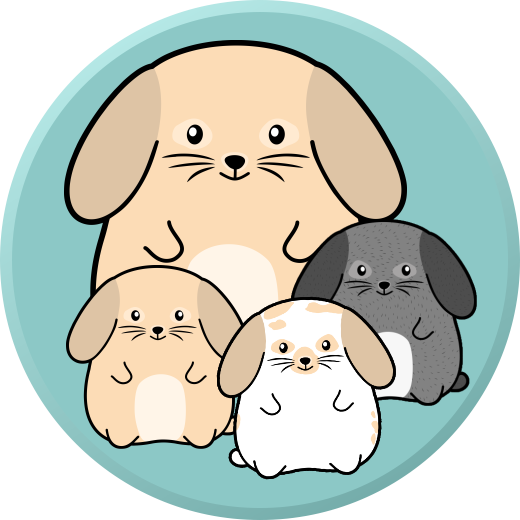|
What? Back that pony up...I thought you just put the boy bunny with the girl bunny and the magic bunny fairy plops a cute litter of bunny kits into the nest box 30 days later! That isn't so? When I first started breeding Hollands, that's what I thought too. Those other breeders are just trying to scare me; how difficult can it be? Plenty!! Let's take a look at some of the most common scenarios when breeding Holland Lop rabbits. *Updated February 2021 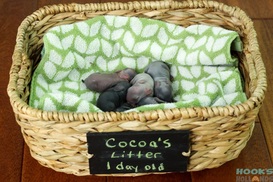 Scenario 1: First-time Mom There are SO many things that can go wrong with a doe who has never kindled before. If the breeding takes, she could deliver her litter flawlessly 30 days later, or they can be born dead, or even worse - be stuck and require assistance just to save the doe or be retained and render the doe sterile. If she has live kits, she can accidentally over-clean them and nip an ear or appendage, her milk might not come in soon enough to keep the kits alive, or she might have too many to care for...and the list goes on. I was fortunate to have my first first-time doe be a "normal" (non-dwarf) Holland Lop who is definitely a brood doe. Cocoa is such a laid back girl and was my son's 4H rabbit. She delivered a whopping SIX live kits, and since she isn't a dwarf, there were no fatal peanut kits. The only issue was that her milk didn't come in sufficiently, but thankfully I had bred veteran Clementine at the same time and could feed Cocoa's babies on Clementine for the first few days. That was time-consuming!! My second first-time doe (Saynora's Guliana) kindled two normals and a peanut, all live, but this is more the exception than the rule. With only two kits to feed, she is doing well so far (she is on day 3 as I type this). I suspect that her awesome Saynora genetics and a nice wide bootie helped to achieve success! 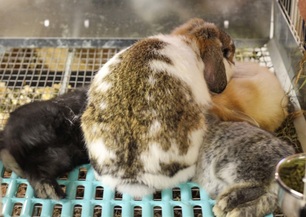 Scenario 2: Veteran Mom with a Good Track Record So you bought a proven doe and babies should just pop out of this girl like Pez candy and earn her the Mother of the Year title. Well, maybe. There are a lot of factors that can affect whether her breeding will take and be delivered successfully. If she's too hot, too cold, too stressed, too old, has underlying health issues, has a big butt ruffle, or she's just not "feelin' it" with that particular buck, the situation becomes complicated. The babies could also grow too large to be delivered live, or the doe might not be able to deliver them at all, and this can be deadly for her. The first veteran doe that I bred was Campo's Clementine, who had previously been residing with my friend Wendy at Hickory Ridge Hollands. She was a great mom for Wendy, and she did the same after I bred her with Campo's Sunny Jim. I caught her just as she flawlessly delivered 5 live Holland Lop kits into her nesting box. Although a bit moody with me, she was a great mom and produced some cute babies! 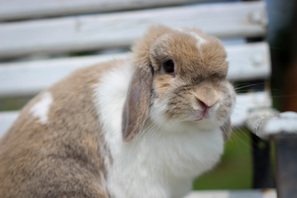 Scenario 3: Veteran Mom on Strike! Your gorgeous new proven doe is finally settled in, and it's time to breed her. You light the candles, put on a little hip-HOP music, and the buck seems to enjoy all five seconds of the act and squeals in appreciation. Ten days later, you're not sure if the doe feels pregnant, so you wait. After a month, your doe begins to nest and pull fur or may do nothing at all, and no babies come. She has missed. Yep, she probably ovulated if she nested at the correct time, but the mouse didn't take the bait so to speak, and no babies result. Now you feel like complete crap for both the doe and your ego as a breeder. Even worse, miss after miss keeps happening like a broken record....for months. This is what happened to me with my beautiful broken cream doe, Campo's Envy. When I bought her in July, she was flown from Washington to Ohio and had just come off a litter and was also bred prior to leaving her old boyfriends. She miscarried as a result of the tumultuous move (I found a bit of blood near her shortly after she arrived, so I am guessing she miscarried at that point). For the next several months, I continued to try to breed her, using the table-breeding method so I could hold up her gigantic "tutu" (ruffle/skirt around her plump rump). One month, she pulled lots of fur on day 29, so when kits didn't ensue in the next couple days, I took her to the vet to check for retained kits...there were none. I was beginning to worry that too much time had passed since her last litter (if you don't breed a doe for more than six months, it can be very difficult or impossible). The breeder I bought her from suggested I try a different buck and let them live together in a pen for a couple days. Long story short, this worked. Sort of. It was so exciting to feel Envy's plump tummy and wiggles on day 30...but it wasn't so fun on day 31 and 32. Finally, on the afternoon of day 32, I found a stillborn kit on the floor of Envy's cage. It looked normal size, and I knew she had to have more inside her still. Envy is so special to me that I wanted to try anything I could to help strengthen her contractions and get any remaining kits out. I gave her a couple Tums and fresh kale for the calcium, brewed her raspberry leaf tea, picked her fresh parsley from the garden, and moved her to a heated exercise pen on the floor so she could move around if needed. The next morning, I gritted my teeth in anticipation when I opened the door to the garage, fully preparing myself for the worst. Thankfully, she passed a second kit on her own, and a few hours later came the placenta. *Update: I never did get live babies out of Envy and ended up retiring her as a pet...a very expensive disappointment for me.
In September, 2020, Camilla delivered a peanut (baby bunny with two copies of the dwarf gene and cannot survive more than a few days to weeks) and then a normal sized kit at the front of her nest box. Thankfully, it was a warm fall day, and I found the baby probably an hour after birth. Though chilled, it was still breathing. I held the baby in my hands and stuffed it in my bra until it was warm. For the next two weeks, I kept the single baby in the nest box, chocked full of Camilla's fur (I always save extra fur when grooming) and a hot water bottle that I refilled three times a day. I delivered Camilla her baby to nurse in the morning and evening, and the end result is the adorable solid orange buck named Fozzie above. As I write this, Fozzie is about five months old, and although his type isn't overly impressive to be a breeding buck, he means to much to me (and Camilla) to part with. He lived with Camilla through about four months of age, when they began mounting each other. They live in double story solid floor condos next to each other and run around the bunny barn together each day (supervised of course). At this point, now that Camilla is five years old, I don't expect any more live litters. Single kits and stillborns are often a signal that it's time to retire a breeding doe. I'm very thankful for the beautiful babies she's given me as well as her companionship. I'm sure there will be many other frustrating situations that I will encounter, but these are just a few of the reasons why breeding Holland Lops in particular can be tricky. They are a dwarf breed with compact bodies, making kindling difficult, assuming they want to breed in the first place! So, the next time you find your jaw dropping at a hefty price tag for a Holland Lop bunny or need to explain to your significant other why a Holland Lop costs so much more than that mixed breed bunny on Craigslist, keep this page bookmarked. There's more to it than a quick visit from the fertile bunny fairy! ...but these adorable floppy-eared fuzzy balls of cuteness are worth the time, effort, and cost in my opinion. :) Speaking of a quick visit...here's a great illustration of just how fast bunnies can breed: |
♥ Welcome! ♥ Hook's Hollands is a small hobby rabbitry on our Ohio farm and is operated by me (Diane) with the help of my family. All of my bunnies are pampered pets whom I adore. This blog serves to spotlight various bunny care topics and share a bit about my 365-days-a-year-with-no-vacations experiences raising bunnies. Categories
All
Archives
February 2021
|



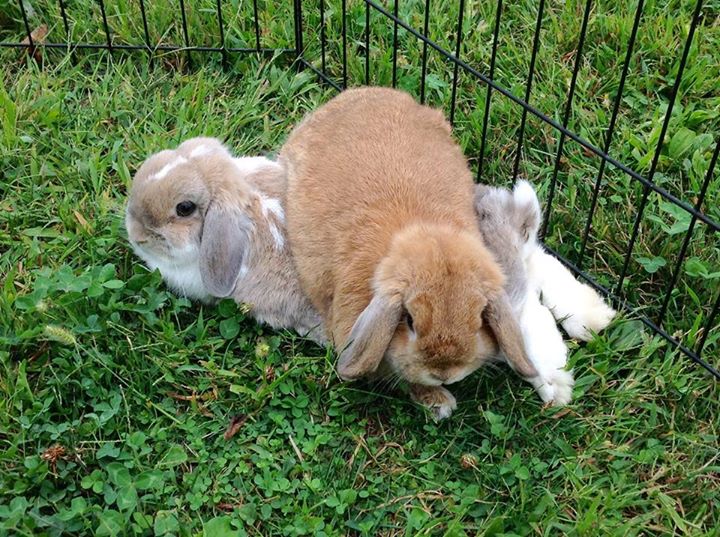
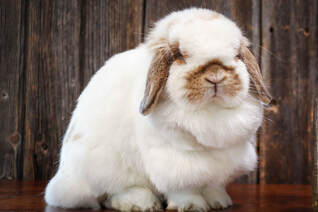

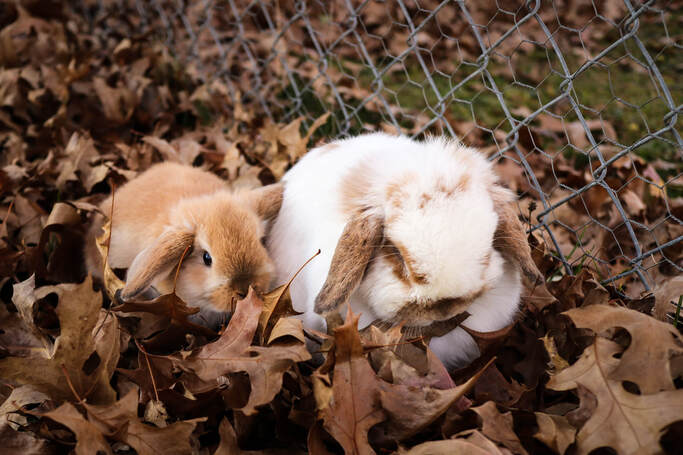
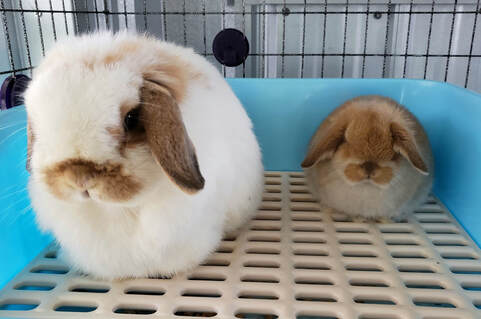
 RSS Feed
RSS Feed

